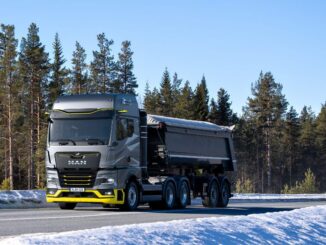
The Alpine Alpenglow hydrogen-powered rolling lab is designed like an endurance racing car with an LMP3 carbon chassis.
Under the Alpine Alpenglow Hy4 carbon bonnet is a 2.0-litre in-line 4-cylinder turbocharged development engine delivering 340 bhp (250 kW). It is fuelled by hydrogen (more precisely, H2 dihydrogen) with direct injection at 40 bar pressure and water injection to reduce NOx emissions. It can reach a maximum of 7,000 rpm and is coupled to a sequential racing gearbox with a centrifugal clutch. The performance is comparable to the petrol equivalent, with a top speed of approximately 270 km/h.
 Developing such an engine requires very specific work because hydrogen is injected in gas form, making it more challenging to create a homogeneous mixture than petrol, which is injected in droplet form. Hydrogen can burn at a much more comprehensive range of concentrations, from 4% to 76%, with both lean and rich mixtures. In all cases, abnormal combustion must be avoided, which means preparing a homogeneous mixture and controlling the temperature in the combustion chamber. The adaptation work carried out on the Alpenglow engine Hy4 has contributed to enriching the expertise of Alpine Racing engineers in the development of a new Alpine engine entirely designed to be hydrogen-powered, with the presentation of a second rolling version before the close of 2024.
Developing such an engine requires very specific work because hydrogen is injected in gas form, making it more challenging to create a homogeneous mixture than petrol, which is injected in droplet form. Hydrogen can burn at a much more comprehensive range of concentrations, from 4% to 76%, with both lean and rich mixtures. In all cases, abnormal combustion must be avoided, which means preparing a homogeneous mixture and controlling the temperature in the combustion chamber. The adaptation work carried out on the Alpenglow engine Hy4 has contributed to enriching the expertise of Alpine Racing engineers in the development of a new Alpine engine entirely designed to be hydrogen-powered, with the presentation of a second rolling version before the close of 2024.
The three Alpenglow tanks Hy4 store hydrogen in gas form (2.1 kg each) under high pressure: 700 bars. They are located in the side pods and aft of the cockpit, in ventilated compartments and sealed off from the interior. A pressure regulator reduces the pressure from 700 to 200 bars before lowering it to 40 bars with direct injection into the combustion chamber.
 Numerous measures have been taken to ensure absolute safety. Composite cylinders under 700 bars are “Regulation 134″* certified, valves are installed for rapid evacuation in the event of a fire, hydrogen presence sensors keep a constant watch, a rigorous start-up procedure is in place with numerous checks. Finally, a colour-coded system alerts the driver and emergency services according to the degree of urgency of each type of incident.
Numerous measures have been taken to ensure absolute safety. Composite cylinders under 700 bars are “Regulation 134″* certified, valves are installed for rapid evacuation in the event of a fire, hydrogen presence sensors keep a constant watch, a rigorous start-up procedure is in place with numerous checks. Finally, a colour-coded system alerts the driver and emergency services according to the degree of urgency of each type of incident.
*Regulation 134: European type-approval standard for the safety of hydrogen-powered vehicles.
Hydrogen in racing, a promising technology with great potential
The two principal solutions for hydrogen-powered propulsion are the fuel cell (which produces electricity to power an electric motor) and the internal combustion engine powered directly by hydrogen. Alpine has opted for the latter, as it combines a host of advantages for a racing car, not least the very similar feel of the engine for the driver and a sound ideally suited to Alpine’s racer philosophy. Among these advantages are its specific power, excellent efficiency under heavy loads, and reduced cooling requirements, as heat is dissipated through the exhaust rather than through radiators. The environmental aspects are also naturally very favourable: its CO2 emissions are negligible, it produces no soot, CO or unburnt hydrocarbons, and NOx emissions can be reduced to levels unattainable for fossil fuel engines.
 These arguments favour continuing along this path after this first rolling version, which continues to be the subject of research and development to optimise this type of promising engine further. Regarding hydrogen storage solutions, Alpine is one of the leading manufacturers with a view to switching to liquid hydrogen, a paradigm-changing state of the art that can be better integrated into the car and refuelled quickly.
These arguments favour continuing along this path after this first rolling version, which continues to be the subject of research and development to optimise this type of promising engine further. Regarding hydrogen storage solutions, Alpine is one of the leading manufacturers with a view to switching to liquid hydrogen, a paradigm-changing state of the art that can be better integrated into the car and refuelled quickly.
Alpine Racing is paying close attention to changes in competition regulations and notes that the ACO will authorise hydrogen-powered cars from the 2027 24 Hours of Le Mans onwards. Formula 1 engines could also switch to hydrogen by 2031.
Guillaume De Ridder, Alpine Racing engineer and race car driver
The driver behind the wheel of the Alpine Alpenglow Hy4 for its first track laps at Spa-Francorchamps has a unique profile: Belgian Guillaume De Ridder is both a rallycross champion and engineer at Alpine Racing. An atypical career that began with years of motor racing in a wide range of disciplines: karting, circuit racing and rallying, culminating with the 2021 FIA RX2e rallycross title.
Source: Alpine



















Be the first to comment